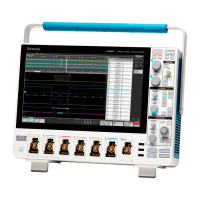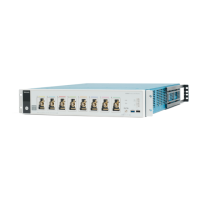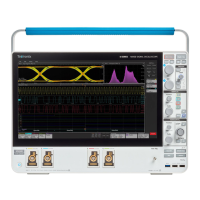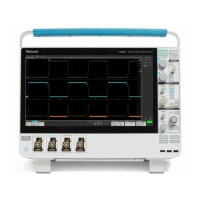Dependencies
In general, math waveforms that include sources as operands are af
fected by updates to those sources:
• Shifts in amplitude or DC level of input sources that cause the source to clip also clip the waveform data supplied to the math
waveform.
• Changes to the vertical offset setting for a channel source that clips its data also clips the waveform data supplied to the math
waveform.
• Changes to the acquisition mode globally affects all input channel sources, modifying any math waveforms using them. For example,
with the acquisition mode set to Envelope, a Ch1 + Ch2 math waveform will receive enveloped channel 1 and channel 2 data, and will
also be an envelope waveform.
• Clearing the data in a waveform source causes a baseline (ground) to be delivered to any math waveform that includes that source
until the source receives new data.
Math waveform sources
You can create Math waveforms from the following:
• Channel waveforms
• Reference waveforms
• Measurement scalars (automated measurements) that measure channel, reference, or math waveforms, or histograms.
• Other math waveforms
Guidelines for working with math waveforms
Use the following guidelines when working with math waveforms:
• Keep math waveforms simple. If the math expression becomes too complex, try separating the expression into more than one math
waveform and then combining the waveforms (for example, Math1 = Math2 + Math4).
• Math waveforms cannot be turned on without a math expression.
• To avoid syntax errors in a math expression, verify the use of operators, parentheses, operands, and the spelling of functions.
• When working with reference waveforms, if one or more reference waveforms are used as part of a math waveform, the number of
frames in the math waveform is the smallest of all source waveforms (reference, math, or channel waveforms).
• If one or more reference waveforms are used in a math waveform, the record length is equal to the smallest of all the source
waveforms (reference, math, or channel waveforms). The math is calculated using the first point from each source, followed by the
next point, and so forth. This is true even if the sources have different times between points in the record.
Math waveform editor syntax
You can build math waveforms using the predefined expressions or the equation editor. To help you create valid math waveforms, the
following tools will block most illegal entries by disabling any window element that would create an invalid entry in the math waveform
expression.
Predefined expressions are accessible using the FFT or Basic Math Types.
The following syntax describes the valid math expressions you can use with the Equation Editor for the Advanced Math Type:
A math expression is composed of settings, functions, scalars and sources.
Settings have the syntax [settingName=settingValue] and are generally applied to measurements. The setting applies to everything to the
right of the closing square brackets.
Measurement concepts
2 Series MSO MSO24 and MSO22 247
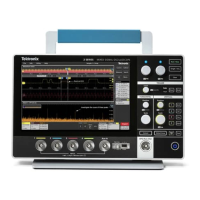
